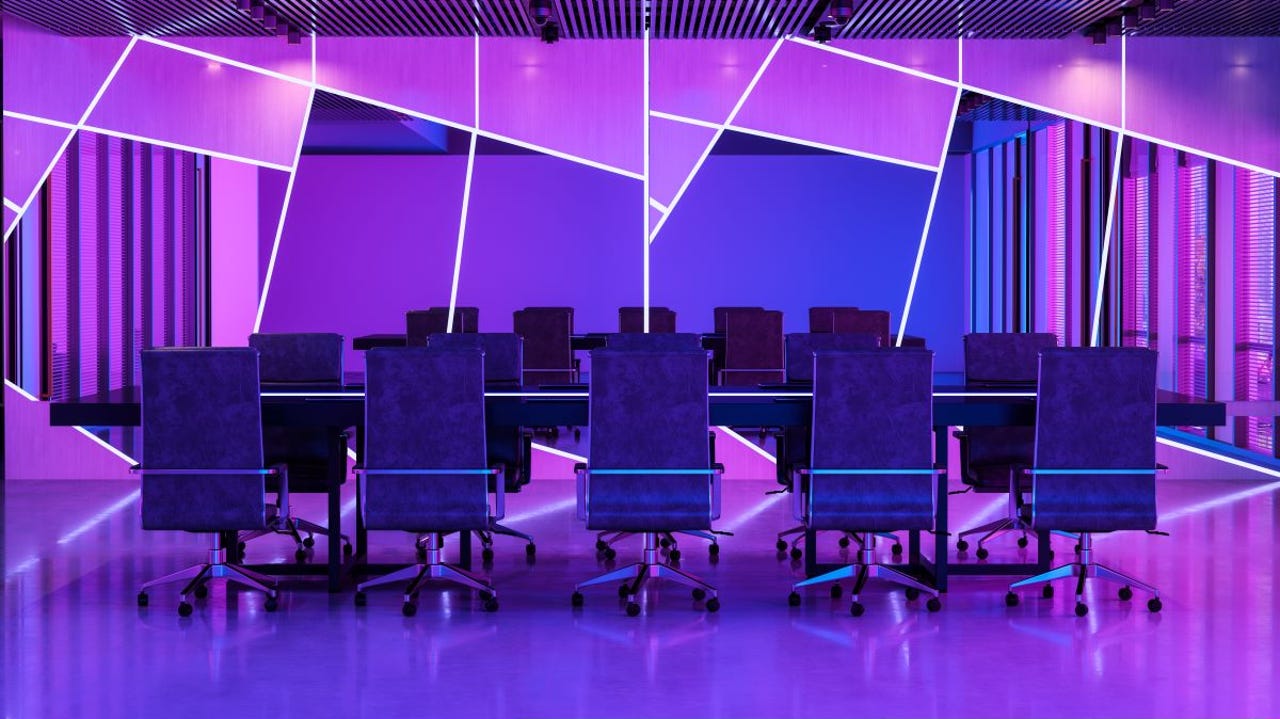Bored of office life? Here's how the metaverse could transform your future job


It's been around half a century since computers entered the workplace, and professionals still spend most of their working days sat in front of a keyboard and monitor.
But we could be on the precipice of a something radically new.
As the dawn of Web 3.0 nears, a number tech companies, analysts and enthusiasts are getting ready to usher in a new era of immersive, reality-blending online experiences colloquially known as the metaverse.
The metaverse is currently more concept than reality, but that's done little to stem the hype. According a global survey by Ciena, a networking systems and software company, 71% of professionals can see the metaverse becoming part of existing work practices. Likewise, 40% think their business will move away from traditional, 'static' collaboration environments to more immersive environments in the next two years – enabled by various extended reality (XR) technologies like augmented reality (AR), virtual reality (VR) and mixed reality (MR).
SEE: What is the metaverse, and who will build it?
XR is already being used in the workplace, though use cases remain limited. Tuong Nguyen, principal analyst at Gartner, says most of the examples showing value today include the use of AR and MR for frontline work in "equipment-intensive" industries like manufacturing, energy and utilities, as well as remote guidance, design simulations and architectural fit – such as determining whether a machine will fit safely into a designated space. There has also been growing adoption of MR in medical education, a notable example being the use of Microsoft's HoloLens headset to train surgeons in some hospitals.
It's important to recognize that XR and the metaverse are not one and the same. "The metaverse doesn't exist, yet," says Nguyen. "AR/VR/MR are experiences or interfaces for digital. You can think of the metaverse as a digital ecosystem for innovation. Therefore, AR/MR/VR would be one way to interact with this ecosystem."
Welcome to the virtual office
Even so, many companies are fervent about the opportunities the metaverse presents, particularly as remote and hybrid working take root and global connectivity accelerates.
Indeed, the metaverse offer a solution to the challenges that hybrid work currently presents by bridging the space between physical and virtual experiences in the workplace. Remote working and virtual meetings have made it harder to build community and retain engagement, resulting in a number of management and culture challenges for businesses.
Professional services firm Accenture has created an immersive meeting and training platform called Nth floor, which has been designed to help onboard new hires virtually.
By offering a "virtual campus", new hires can participate in events and teambuilding activities even if their role isn't office-based, helping them to get connected with the company and company values.
Most importantly, it's developing a workplace experience where people can participate, contribute and feel like they belong, regardless of where they are, says Jason Warnke, senior managing director and digital experience lead at Accenture.
"The feedback has been that it helps them understand more about our culture, who we are as a company and how our culture comes to life day to day," says Warnke.
"We've also created 20-plus digital twins of Accenture's physical spaces to provide our people with familiar environments in the metaverse. We've already hosted more than 1,000 community events in these spaces, from small group innovation sessions to larger team meetings and social events."
Nth Floor is professional service firm Accenture's self-styled 'virtual campus'
Global design firm Designit has recently been working with city planners and local councils to better understand how mixed reality and the metaverse can transform public services and urban experiences.
This includes the advancement of 'digital twins' – a virtual representation of an object, system or process that can be used to simulate real-world performance scenarios in a safe environment.
Through XR technologies, planners and designer could access expert advice and instruction while carrying out tasks in industrial, agricultural or fieldwork scenarios, all while maintaining real-time feedback on the effects of their actions on a complex system, says Sam Hoey, lead designer at Designit London.
Similarly, XR can be used to increase health and safety for workers who work in hazardous environments, connecting with on-the-ground IoT sensors and robotics to carry out tasks safely and remotely.
This makes XR a powerful tool for skills training in complex tasks. "There are a variety of ways the metaverse can be applied in a workplace environment, and one increasingly positive trend we're seeing is the use of it in skills training, utilising 3D space to demonstrate concepts and practise new tasks virtually, in a controlled environment," says Hoey.
"This is really beneficial to businesses considering that, according to research, humans remember 10% of the material they read, 20% of the information they hear, but 90% of what they do or experience."
XR: a tool for greater collaboration?
It's not just specialist roles that stand to benefit from metaverse tech in the workplace: frontline workers will also be empowered by tools that facilitate better communication and connection across teams.
Christine Trodella, a VP within Facebook owner Meta's Reality Labs, believes the metaverse's reality-traversing capabilities could materialize in a number of ways, from corporate employees attending meetings as a hologram to architects collaborating on 3D designs in the metaverse.
Trodella says Meta's Horizon Workrooms is already helping Meta explore new ways of working, providing virtual spaces where teams can conduct meetings and perform collaborative work "unbound by physical location or department."
"While it will revolutionize how we work, the metaverse won't change the things we value at work – communication, community and connection – but rather augment them," Trodella tells ZDNET.
"Companies need to foster these cultural values today if they want to maximise the benefits the metaverse will bring in the future, ensuring all workers are empowered to have a voice and being willing to embrace change that's best for their teams."
Meta hopes the metaverse will bring more immersion to virtual meetings and social events
But to ensure equality, companies need to ensure that participation in new mixed reality technologies is available organization-wide – not just to workers with VR headsets. "That's why it's important that the metaverse is built with 2D access points in mind," Trodella adds.
As a company that is already heavily invested in workplace collaboration and communication tools, Microsoft also recognizes the potential of mixed reality technologies as a means of blending digital and in-person experiences.
This has been a long-term investment for Microsoft, with the company already boasting a suite of software and hardware products poised to support metaverse-like experiences, including Microsoft Cloud, Azure Digital Twins and its HoloLens 2 mixed reality headset.
Alysa Taylor, corporate vice president of Industry, Apps, and Data at Microsoft, believes the metaverse represents a "paradigm shift" towards data-rich work environments grounded in real-world scenarios, allowing for "persistent, digital representations" connected to "people, places, things or processes."
Microsoft HoloLens is a MR headset that has seen adoption in some specialist settings
Organizations are recognizing the potential impact of metaverse solutions across a variety of industries and use cases, says Taylor. "We're seeing industrial metaverse scenarios gain momentum, whether it's a digital twin of a factory floor or real-time visualization of the foot traffic in a retail store," Taylor tells ZDNET.
Taylor says the metaverse will also help create more meaningful interactions across a geographically distributed workforce – which Microsoft is exploring as part of its efforts to help remote employees feel more connected within Microsoft Teams. "We're seeing new remote collaboration scenarios, allowing experts around the world to support their colleagues as though they were in the room, without the expense or environmental impact of long-distance travel," says Taylor.
Not there yet
While it's fun to imagine new ways of working filled with headsets, holograms and 3D avatars, it's important to acknowledge that the metaverse is barely more than idea and certainly not a great tech ecosystem - yet.
AR, MR and VR have already found their footing within select industries and roles. Microsoft HoloLens, for example, has been used within select industrial settings for a number of years meanwhile virtual reality continues to bloom in the gaming community, despite its high entry requirements.
But even so, the metaverse remains a very nascent concept. Many of the supportive technologies exist, but for now they remain disparate parts of a future greater whole. "All the XR environments that exist today, such as Meta's Horizon Worlds and Microsoft's AlspaceVR, are siloed: they're missing the equivalent of cross-site linking on the web," says Forrester analyst David Truog.
SEE: The metaverse has one big challenge to overcome
"For example, a user in Horizon Worlds can enter a portal to be transported to a different location in Horizon Worlds but it's impossible for a portal to transport them to a location in AltspaceVR, and the same is true in the opposite direction."
Truog likens the current stage in the metaverse lifecycle to that of the early internet, during which the online world was made up of siloed services from service providers like AOL, CompuServe and Prodigy. As such, the metaverse does not exist yet — what we're currently witnessing are "metaverse precursors", and only once there is a means of linking and navigating these services will we truly enter the true metaversal era.
"The future ability to traverse between these environments already has a name in the industry: 'metatraversal'. But it will require a widely adopted standard, like for URLs on the web," says Truog.
"The Metaverse Standards Forum was formed a few months ago to standardize metatraversal among many other things the metaverse will need — but it will take at least two years before they hash out a stable standard for enabling metatraversal."